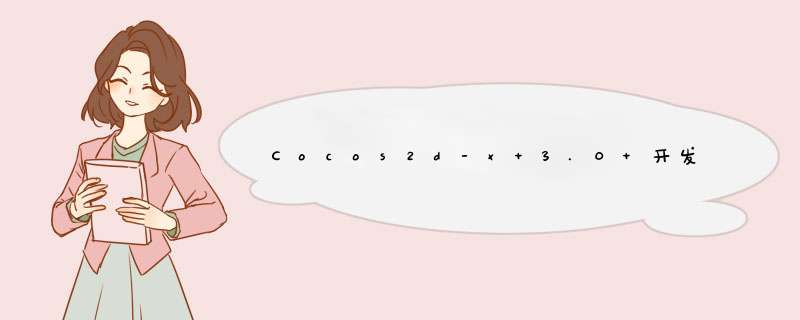
使用cocoStudio可以方便的制作动画,接下来的工作就是在我们的程序中使用制作的动画。这篇中,我将使用程序将两个动画连接起来。有图有真相:
承接上一篇,我们再制作一个动画。制作动画的方法与之前没有差别,不太熟悉的同学可以看:Cocos2d-x 3.0开发(六)使用cocoStudio创建一个骨骼动画。在“动作列表”中右击,“添加动画”然后编辑就成。
我们新制作的动画的结束点,要与上一篇中制作动画的开始点重合,这样在连接的时候,画面就不会跳动。
制作好后我们将动画导出。
3、制作UI既然能够方便的制作UI,我就顺手做了一个控制动画播放的UI。制作方法之前也提到过。没有什么差别。使用UI编辑器制作UI,并将其导出。
运行脚本创建我们的项目,将导出的动画、UI放到Resource文件夹中。
然后重写init方法:
bool HelloWorld::init(){ ////////////////////////////// // 1. super init first if ( !Layer::init() ) { return false; } Size visibleSize = Director::getInstance()->getVisibleSize(); Point origin = Director::getInstance()->getVisibleOrigin(); auto ui = dynamic_cast<Layout*>(CCUIHELPER->createWidgetFromJsonfile("ControlUI.ExportJson")); ui->getChildByTag(UI_button_PLAY1)->addtouchEventListener(this,toucheventselector(HelloWorld::touchCallBack)); ui->getChildByTag(UI_button_PLAY2)->addtouchEventListener(this,toucheventselector(HelloWorld::touchCallBack)); ui->getChildByTag(UI_button_CONN)->addtouchEventListener(this,toucheventselector(HelloWorld::touchCallBack)); ui->getChildByTag(UI_button_disCONN)->addtouchEventListener(this,toucheventselector(HelloWorld::touchCallBack)); auto uiLayer = UILayer::create(); uiLayer->addWidget(ui); this->addChild(uiLayer); return true;}voID HelloWorld::touchCallBack(Object* obj,touchEventType type){ //will play } 5、加载动画 动画的导出文件也是一个Json。载入后被封装到一个Armature对象中。Armature是NodeRGBA的子类,所以它可以直接被addChild到父节点中。加载所用的是ArmatureManager中的方法。它是一个单例,管理整个场景中的Armature。我们在编辑器中编辑的动画是Animation,它被封装在Armature中了。因此这是一个三层的结构。ArmatureManager最大,然后是Armature,最后是Animation。我们播放动画用的都是Animation中的方法。
说完了原理,我们来看看代码。首先在init中添加加载Armature。
[cpp] view plain copy print ? ArmatureDataManager::getInstance()->addArmaturefileInfo("MyAnimation.ExportJson"); Armature*armature=Armature::create("MyAnimation"); armature->setTag(AM_MYANIMATION); armature->setposition(Point(origin.x+visibleSize.wIDth/2, origin.y+visibleSize.height/2)); this->addChild(armature);
ArmatureDataManager::getInstance()->addArmaturefileInfo("MyAnimation.ExportJson");Armature* armature = Armature::create("MyAnimation");armature->setTag(AM_MYANIMATION); armature->setposition(Point(origin.x + visibleSize.wIDth/2,origin.y + visibleSize.height/2));this->addChild(armature); 然后重写touchCallback方法控制播放动画。
[cpp] view plain copy print ? voIDHelloWorld::touchCallBack(Object*obj,touchEventTypetype) { autouiBt=dynamic_cast<UIbutton*>(obj); if(!uiBt) { return; } inttag=uiBt->getTag(); autoarmature=(Armature*)getChildByTag(AM_MYANIMATION); switch(type) { casetouchEventType::touch_EVENT_ENDED: if(tag==UI_button_PLAY1) { armature->getAnimation()->play("hit"); } elseif(tag==UI_button_PLAY2) { armature->getAnimation()->play("fall"); } elseif(tag==UI_button_CONN) { //willconn } elseif(tag==UI_button_disCONN) { //willdisconn } break; default: break; } }
voID HelloWorld::touchCallBack(Object* obj,touchEventType type){ auto uiBt = dynamic_cast<UIbutton*>(obj); if(!uiBt) { return; } int tag = uiBt->getTag(); auto armature = (Armature*)getChildByTag(AM_MYANIMATION); switch (type) { case touchEventType::touch_EVENT_ENDED: if(tag == UI_button_PLAY1) { armature->getAnimation()->play("hit"); } else if(tag ==UI_button_PLAY2) { armature->getAnimation()->play("fall"); } else if(tag == UI_button_CONN) { //will conn } else if(tag == UI_button_disCONN) { //will dis conn } break; default: break; }} 6、处理动画事件
在Animation中有动画事件的概念,每一个动画开始和结束都会事件。我们需要做的就是监听这个事件并为其写好响应函数。
所以接下来我们完善touchCallback函数,并添加一个监听函数。
//......else if(tag == UI_button_CONN){ armature->getAnimation()->setMovementEventCallFunc(this,movementEvent_selector(HelloWorld::movementCallback));}else if(tag == UI_button_disCONN){ armature->getAnimation()->setMovementEventCallFunc(this,nullptr);}//......voID HelloWorld::movementCallback(Armature * armature,MovementEventType type,const char * name){ if (type == COMPLETE) { if (strcmp(name,"fall") == 0) { Armature* arm = (Armature*) getChildByTag(AM_MYANIMATION); arm->getAnimation()->play("hit"); } }} 编译运行,就可以看到动画连接起来了。
7、总结
通过ArmatureDataManager单例来加载动画,将其关联到程序中。动画事件的监听,对动画的行为进行处理。使用这些方法我们可以灵活的使用cocoStudio创建的动画了。
Demo下载:http://download.csdn.net/detail/fansongy/6439225
本篇博客出自阿修罗道,转载请注明出处,禁止用于商业用途:http://blog.csdn.net/fansongy/article/details/12955989
总结以上是内存溢出为你收集整理的Cocos2d-x 3.0 开发(七)在程序中处理cocoStudio导出动画全部内容,希望文章能够帮你解决Cocos2d-x 3.0 开发(七)在程序中处理cocoStudio导出动画所遇到的程序开发问题。
如果觉得内存溢出网站内容还不错,欢迎将内存溢出网站推荐给程序员好友。
欢迎分享,转载请注明来源:内存溢出

 微信扫一扫
微信扫一扫
 支付宝扫一扫
支付宝扫一扫
评论列表(0条)